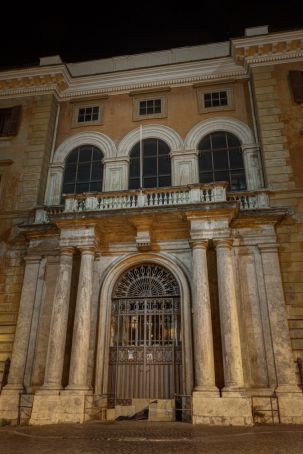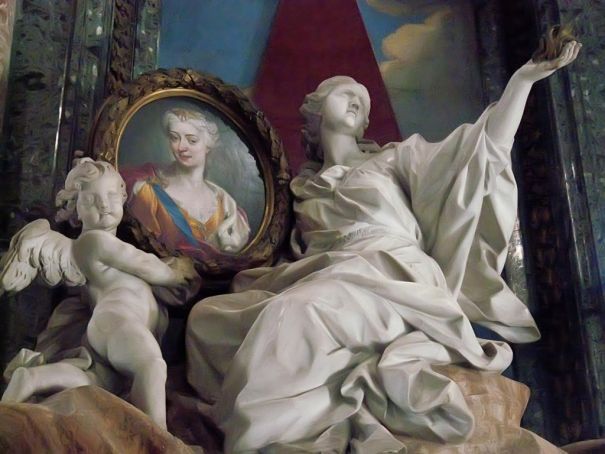Traces of the House of Stuart can still be seen in Rome 300 years after the Jacobite Rising in Scotland.
The Jacobite Rising in Scotland in 1715 was the second of three unsuccessful attempts made by James Francis Edward Stuart to regain the throne of Great Britain forfeited by his father James II in 1688. By the time James Francis landed in Scotland in early January 1716, the campaign was all but lost. Described by his enemies as Old Mr Melancholy, James lacked the charisma to invigorate the flagging spirits of his followers.
With little option but to return to France, James was told in no uncertain terms by the French regent, Philippe d’Orléans, that he was no longer welcome there. The homeless exile thus began a series of journeys to Avignon, Pesaro, Urbino and Madrid from where he launched yet another unsuccessful invasion of Scotland before settling in Rome in 1719 in Palazzo Muti in Piazza dei SS. Apostoli, put at his disposal by Pope Clement XI. He was to spend the next 47 years of his life there, apart from a short stay in Bologna.
Despite the impression given by Hanoverian enemies that Palazzo del Re, as it was known, was a very dreary little court, nothing could be further from the truth. The Stuart court in Rome functioned as a virtual embassy for English-speaking travellers in the 18th century. As well as providing passports, diplomatic protection and medical care, the palazzo also made Anglican services available for James’ Protestant servants; Hanoverians and Whigs were as welcome as Jacobites. At a time when only Catholics could be buried inside the walls of Rome, James III petitioned the pope on behalf of his Protestant subjects in the city and was a granted a piece of land near the Pyramid of Cestius for their burial. It was thus that Rome's Non-Catholic cemetery came in to being, much visited by tourists today wanting to see the graves of Keats, Severn and Shelley.
The Stuart court also functioned as an important cultural forum. A number of famous painters such as Antonio David, Francesco Trevisani and particularly Pompeo Baroni were very grateful for the patronage of the Stuart court, a patronage that led to further commissions from British and Irish aristocrats making the Grand Tour. One contemporary claimed that the best music in Rome was provided by the concerts in Palazzo del Re. While foreign ambassadors were allowed one opera box in honour of the monarchs they represented, James III, as the legitimate monarch of three kingdoms, was accorded three boxes in the Teatro Aliberti, where he was formal patron. Indeed, Count Antonio Alibert, as manager of the theatre, decreed that the libretto of every opera performed there should be dedicated to either James or his queen. Nine of Handel’s operas composed between 1723 and 1737 were performed in Rome before going to London, with seven of them being dedicated to James and his Polish wife, Maria Clementina Sobieska. In 1725 Cardinal de Polignac, the French ambassador in Rome, commissioned Vivaldi to compose a serenata for James III.

Great joy greeted the birth of James and Maria Clementina’s first-born on New Year’s Eve 1720. Christened Charles Edward Louis John Philip Casimir Maria Sylvester, he is better remembered as Bonny Prince Charlie. Fireworks were let off, the pope sent a present of 10,000 scudi, and wine flowed freely. The fact that Carluccio, as his father called him, was born so close to Christmas and the new year added a symbolic dimension to the birth.
Maria Clementina gave birth to a second son, Henry Benedict, in March 1725. Soon afterwards relations with her husband deteriorated and the queen took refuge in the convent of S. Cecilia in Trastevere. When she finally rejoined her husband after a separation of 16 months, James had gone to Bologna.
Though both returned to the Palazzo del Re in Rome by mid-June 1729, it was clear that there would never be a full reconciliation and Maria Clementina became withdrawn; her health suffered as a result of her excessive fasting and she died on 18 January 1735. Pope Clement XII ordered a state funeral and after a magnificent service in the Basilica dei SS. Apostoli her corpse was borne in a splendid procession to St Peter's Basilica where she was buried in the crypt. The Conventual Friars who were in charge of SS. Apostoli erected a monument there in her honour in 1737 at the pope’s command. A much more imposing monument was erected to her in the left aisle of St Peter's in 1742, composed of both sculptural figures and a mosaic portrait of the queen. One of the very few representations of a lay person to be found in the basilica, this portrait was the cause of some controversy because the prudish Cardinal Landfredini objected to the queen’s plunging neckline. Pope Clement XII, blind but wily, replied that no decision on the suitability or otherwise of the portrait should be taken while work was still in progress. Landfredini’s death before Pietro Paolo Cristofari had finished his mosaic ensured that is still to be seen in St Peter's.

In early January 1744, Bonnie Prince Charlie secretly left Rome for France to embark on the last great Stuart attempt to regain the throne, landing in Scotland in July 1745. Despite initial successes, the prince’s campaign came to a sorry end at the battle of Culloden in April 1746. On the run in the heather for nearly six months, Charles was finally rescued by a French privateer, ironically named L’Heureux. Arriving back in Paris in October, he was feted like a hero, but before long his erratic behaviour, drinking and womanising proved too much for Louis XV, who ordered his arrest and deportation from French territory.
Back in Rome, James’ disappointment at the failure of the Scottish landing and anxiety for his son’s safety was aggravated by the reports from France of his recklessness. Charles spent the next 17 years wandering round Europe in various disguises, including a secret visit to London where he converted to Anglicanism. James’ other son, Henry, Duke of York, was created cardinal in 1747, ordained priest in 1748 and given the church of S. Maria in Campitelli. While Henry’s elevation to the cardinalature gave some solace to his father, it caused a rift between him and Charles. The latter returned to Rome only on 23 January 1766, over three weeks after his father’s death. Though James was given a magnificent state funeral by Clement XIII (1758-69) and burial in St Peter's, Clement had come to terms with the Hanoverian regime and had no qualms in refusing recognition to Charles as de jure monarch. Despite the pope’s acknowledgement of the prince as master of Palazzo del Re, the withdrawal of the papal guard and the removal of the royal coat of arms indicated that it was no longer a royal court.
Notwithstanding these setbacks, Charles was reconciled with both his brother and the Catholic Church, and married in 1772. Unfortunately, he resumed his weakness for what Cardinal Henry called ‘the nasty bottle’ and treated his wife Louise of Stolberg abominably, while she in turn ended up having an affair with the poet Vittorio Alfieri. Befriended by Cardinal Henry, Louise was granted a formal separation from her husband in 1784. The following year Charles' health began to fail and he died on 30 January 1788, attended by his brother. Despite Cardinal Henry’s best efforts, the pope refused a royal funeral and burial in St Peter's, citing as his reason that Charles had never been recognised as monarch. The cardinal compensated by celebrating his brother’s obsequies with due magnificence in the cathedral of Frascati, where he had been bishop since 1761.
During the Napoleonic invasion of Rome, Cardinal Henry had to flee to Padua and Venice from Frascati, leaving all his possessions behind. On hearing of his predicament, the Hanoverian King George III generously granted him an annual pension of £4,000. On the restoration of peace between France and the Vatican, the cardinal was able to return to Frascati and pass his remaining years as Dean of the College of Cardinals before dying on 13 July 1807. In 1815 the Prince Regent and future king George IV, another Hanoverian, commissioned sculptor Antonio Canova to create a monument to the Stuart dynasty. It was installed in St Peter's in 1819 opposite the monument to Maria Clementina Sobieska.
It is said that while history is written by the winners, the last word remains with the losers. The house of Stuart may not have had the last word, but Rome and its churches are dotted with monuments to remind us of a time when Palazzo del Re was a thriving centre of Roman social, cultural and political life.
Mícheál MacCraith
Fr Mícheál MacCraith OFM is the Guardian of St Isidore's College in Rome.
This article was published in the September 2015 edition of Wanted in Rome magazine.


















